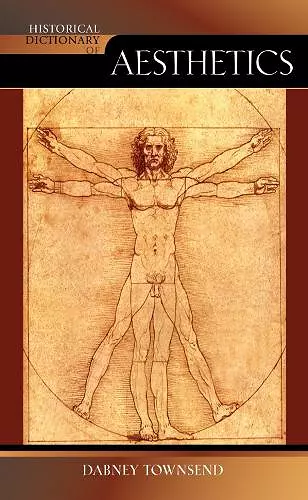Historical Dictionary of Aesthetics
Format:Hardback
Publisher:Scarecrow Press
Published:5th Sep '06
Currently unavailable, and unfortunately no date known when it will be back

Aesthetics is not a "factual" discipline; there are no aesthetic facts. The word itself is derived from the Greek word for "feeling" and the discipline arises because of the need to find a place for the passions within epistemology—the branch of philosophy that investigates our beliefs. Aesthetics is more than just the study of beauty; it is a study of that which appeals to our senses, most often in connection with the classification, analysis, appreciation, and understanding of art. The Historical Dictionary of Aesthetics covers its history from Classical Greece to the present, including entries on non-western aesthetics. The book contains a chronology, a list of acronyms and abbreviations, an introductory essay, a bibliography, and hundreds of cross-referenced dictionary entries on the main concepts, terminology, important persons (philosophers, critics, and artists), and the rules and criteria we apply in making judgments on art. By providing concise information on aesthetics, this dictionary is not only accessible to students, but it provides details and facts to specialists in the field.
...helpful....something for the recommended reading list.... * s, Vol. 21, No. 6 (2007) *
The entries are consistently clear and quite broadly accessible, helpfully peppered with much cross-referencing....Recommended. * CHOICE, March 2007 *
Kant adopted it in his Critique of Judgment but who coined the term "aesthetics?" What role does horror play in recent theories of mass art? What are the rules that make up a standard of taste? Here Townsend (philosopher, Armstrong Atlantic State U.) makes it clear that the study of aesthetics goes far beyond determining what is beautiful, giving terms, great thinkers and artists, movements, classifications, means of analysis and appreciation and synopses of significant texts. The result, despite the complexities inherent in the study of aesthetics, is accessible enough for most general readers yet provides starting-points for those going deeper into the subject. He also supplies a bibliography sorted by topic, a chronology and an introduction providing a solid framework for the entries. Townsend brings in a number of theorists, Jung, Marx, Panofsky and Derrida among them, and explains the trickier terms in plain language. * Reference and Research Book News, November 2006 *
ISBN: 9780810855397
Dimensions: 224mm x 146mm x 28mm
Weight: 626g
416 pages